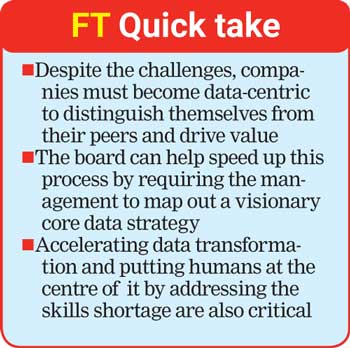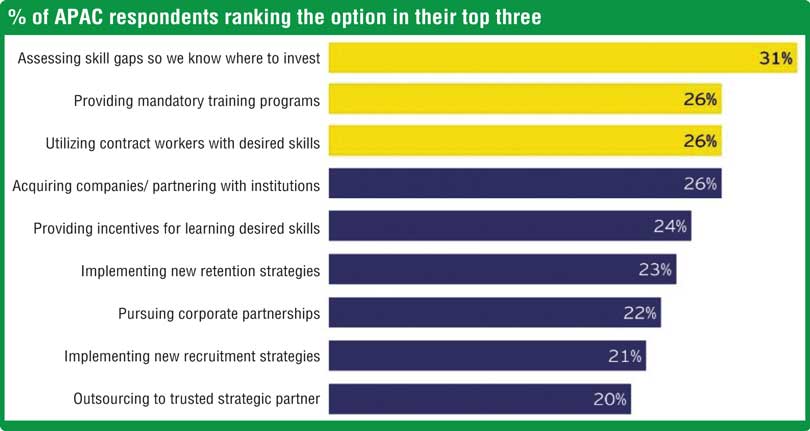Sunday Dec 14, 2025
Sunday Dec 14, 2025
Tuesday, 19 March 2024 00:00 - - {{hitsCtrl.values.hits}}
 How do data-centric enterprises set themselves apart from their peers?
How do data-centric enterprises set themselves apart from their peers?
 Organisations are entering a new frontier of data and analytics, which will drive pivotal decisions, processes and interactions. Unsurprisingly, more than half (57%) of Asia-Pacific senior executives in the 2022 biannual EY study, Tech Horizon, identified data and analytics as their top investment priority in the next two years, up from 31% in 2020. What’s more, tech-enabled transformations in the region that exceed expectations are predicted to yield an average annual revenue growth of 6.2%, compared with 5.4% for transformations that fall short of expectations.
Organisations are entering a new frontier of data and analytics, which will drive pivotal decisions, processes and interactions. Unsurprisingly, more than half (57%) of Asia-Pacific senior executives in the 2022 biannual EY study, Tech Horizon, identified data and analytics as their top investment priority in the next two years, up from 31% in 2020. What’s more, tech-enabled transformations in the region that exceed expectations are predicted to yield an average annual revenue growth of 6.2%, compared with 5.4% for transformations that fall short of expectations.
How do data-centric enterprises set themselves apart from their peers? Essentially, they use data as a shared asset to create intelligence and insights for customers and other stakeholders. They also have a data fabric across the entire business instead of siloed sets of facts. Data expertise is not just limited to the IT department, but also infused across business groups, internal operations and customer relationships. Mundane tasks are automated, allowing executives to focus on creating value. Employees make more informed decisions on the spot, and these tactical decisions aggregate up into insightful predictive analytics. Data ceases to be retrospective — it is used to predict the future instead.
The board should require the management to map out a visionary core data strategy identifying high-priority use cases that create value with data centricity in mind. The strategy must also involve a robust data governance plan, high-level architecture that enables the execution of use cases and a plan to increase data literacy
This is not a pipe dream for businesses though it remains a lofty goal for many. The EY study showed that only 16% of businesses in the Asia-Pacific region say that they are data-centric today. Boards can guide their teams to chart and accelerate the journey to the next generation of data and analytics in three ways.
Develop a robust data strategy
To start with, the board should require the management to map out a visionary core data strategy. This should serve as a high-level blueprint of data flows and usages. It also delineates how data and analytics supports the firm’s strategic vision.
A robust data strategy has several key attributes. First, it should identify high-priority use cases that create value while moving the business toward data centricity. The aim here is to deploy an accelerated timeline and scale up fast. Second, a robust data governance plan that outlines how data will be managed, including the policies, stewardship and operating model needed to support data management, must be in place. Third, it’s key to have high-level architecture that enables the execution of use cases. Fourth, a plan to increase data literacy is needed to democratise data (i.e., make it more user-friendly and accessible) across the enterprise and give decision-makers access to data to drive value. Boards should critically assess if the organisation’s data strategy encompasses the above.
 To succeed in achieving data centricity, boards should require the formation of a dedicated data team equipped with business and IT skills. The team must also be empowered with the leadership and resource support it needs to achieve this strategy. This does not mean that fulfilling the enterprise’s data-centric vision is a single functional responsibility. Rather, it is the mandate of the entire leadership team, which must adopt a growth mindset and view data as a differentiator for the business.
To succeed in achieving data centricity, boards should require the formation of a dedicated data team equipped with business and IT skills. The team must also be empowered with the leadership and resource support it needs to achieve this strategy. This does not mean that fulfilling the enterprise’s data-centric vision is a single functional responsibility. Rather, it is the mandate of the entire leadership team, which must adopt a growth mindset and view data as a differentiator for the business.
Accelerate data transformation
In many organisations, data exists as disparate bits of information. Such silos not only block interoperability and integration, but also prevent insights from being generated at the enterprise level and create conflicting data.
How would the transformation of data look like? Instead of static facts, data is now managed by artificial intelligence (AI). Real-time data feeds replace stale reports. Instead of being used as an application, AI now serves as a foundation for other technologies. Rules-based analytics becomes neural and intuitive.
To catalyse the shift, the board should request the management to start assessing its technology stack today — including the infrastructure, cloud, AI, data and analytics — to identify gaps and determine where each of these components should be in the future. It is important to aggregate and curate data from a vast array of enterprise information systems, suppliers, customers, markets, regulators, internal control systems, Internet of Things (IoT) devices and sensor networks. Given the expanded user base of data, democratising data is a must. The management should also consider using emerging technologies that rationalise data flows and improve their management.
Data-centric companies are well placed to stand out from their peers. The board can help accelerate the organisation’s journey toward data centricity by requiring the management to map out a visionary core data strategy, speed up data transformation and put people at the centre of such transformation
While the benefits of data transformation will be profound, achieving it is not without challenges. 32% of Asia-Pacific respondents in the EY study cited high technological cost as the number one challenge to achieving transformation. The need for higher computational power, complexity of connecting and integrating diverse data systems, and greater consumption commitments to cloud service providers all lead to increased costs. Migrating legacy systems (28%) and building complex security and privacy requirements (26%) were other top challenges cited. Board support for a dedicated data team empowered by leadership backing to disrupt and transform can move the needle in addressing these challenges.
Put humans at the heart of data transformation
The EY study found that enterprises that put the human element at the centre of data transformation tend to succeed in digital transformation. In terms of data centricity, this highlights the need for strong leadership, the spread of data literacy and digital mobilisation of the wider workforce. Such transformation will see the ranks of knowledge workers expanding across the organisation.

However, the skills shortage is a clear barrier to achieving this vision, exacerbated by the prevailing Great Resignation. Keeping employees, particularly the digitally skilled, engaged and fulfilled is crucial. Upskilling and retention has become a top priority, with 70% of Asia-Pacific companies in the EY study focused on plugging the technology skill gaps of existing employees. Key actions include assessing skill gaps (31%), providing mandatory training programs (26%) and offering incentives to encourage learning of desired skills (24%). The figure below shows other actions that companies in the Asia-Pacific region are taking to secure digital skills needed to drive their transformation.
Actions companies are taking to secure digital and technology-related skills for transformation
Boards should assess the effectiveness of the enterprise’s talent ecosystem approach (i.e., a hybrid of hiring new talent, upskilling employees, adopting third-party solutions, automation and gig workers) and the extent to which it supports the achievement of data centricity.
Companies that are agile in transforming data while putting humans at the centre will be well placed to become data-centric. A visionary data strategy is a must and boards must start to look at decision audits, with a percentage of decisions driven by data itself as the organisation progresses. Such Organisations will be well positioned to reinvent themselves and use technological disruption as an enabler to unlock new value sources.
Boards should consider the following questions:
(Duminda Hulangamuwa is the Country Managing Partner, Ernst & Young, Sri Lanka and Gaurav Modi is Managing Partner – Consulting, ASEAN and Singapore.)